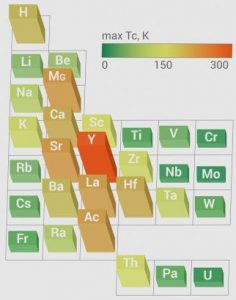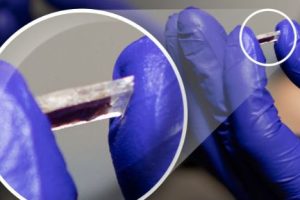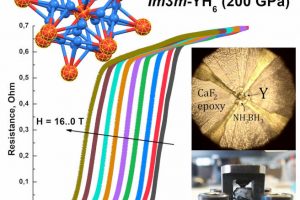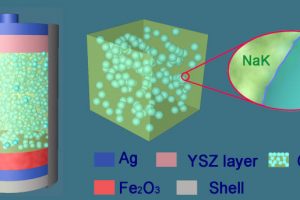
Hydrides are thought to offer the potential for ‘high-pressure’ superconductors, as opposed to the usual ‘low-temperature’ superconductors – although they still require low temperatures.
“There are predictions that metallic hydrogen can show superconducting properties at almost room temperature – the catch is in the pressure required, which is more than four million atmospheres, almost at the limit of our technical capabilities” according to The Moscow Institute of Physics and Technology (MIPT), which worked with Skoltech. “That is why scientists are looking at compounds of hydrogen and another element. The current record of -23°C was shown last year for lanthanum decahydride [LaH10] at the pressure of 1.7 million atmospheres – still too high to enable practical use.”
Using the data on the superconducting critical temperature for a number of metal hydrides, a team including Professor Artem Oganov of both Skoltech and MIPT found a rule that predicts the maximum superconducting critical temperature for metal hydrides based only on the number of d + f electrons in the metal atom structure.
“The connection between superconductivity and the periodic table was puzzling at first,” said Oganov. “We are still not fully certain about its origin, but we think that it is because elements at the boundary between s- and p- or s- and d-elements have electronic structure unusually sensitive to the crystal field, and this is perfect for the electron-phonon coupling, which is the cause of superconductivity in hydrides.”
Using this rule, they created a neural network to explored potential hydrides for which no reliable information existed, and predicted new hydrides of potassium, zirconium, hafnium, titanium, magnesium, strontium, barium caesium and rubidium.
“The highest-temperature superconducting hydrides are formed by metals roughly between second and third groups of the periodic table, according to the paper ‘On distribution of superconductivity in metal hydrides’, published in the journal Current Opinion in Solid State & Materials Science. “Results of the study of actinoids and lanthanoids show that they form highly symmetric superhydrides xH7-xH9, but the increasing number of d- and especially f-electrons affects superconducitivity adversely. Hydrides of late transition metals – for example the platinoids – and all but early lanthanoids and actinoids are not promising for high-temperature superconductivity.”
Example of potential superconductors are strontium hexahydride (-84°C at 100GPa), and the theoretical BaH12 (possibly -59°C).
In 2019, Oganov and colleagues from Russia, the US and China synthesied cerium superhydride (CeH9) which superconducts at 100-110K and 120GPa, and Oganov was also involved with a team that found thorium hydride (ThH10) that works at 161K.
“Using the newly discovered rule and the neural network we can focus on more complex compounds which are even more promising in our quest for room-temperature superconductivity – ternary superhydrides that contain two elements and hydrogen,” said fellow researcher Dmitrii Semenok of Skoltech. “We have already predicted a number of hydrides that can rival or exceed LaH10.”
Other organisations involved in this research include the Dukhov Research Institute of Automatics (VNIIA) and the Research Computer Center of Lomonosov Moscow State University.
 Electronics Weekly Electronics Design & Components Tech News
Electronics Weekly Electronics Design & Components Tech News



